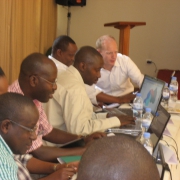Millions awarded for maternal health innovations
The Saving Lives at Birth program held its DevelopmentXChange event last week in Washington DC. The event was hosted by Secretary of State Hillary Clinton and USAID Administrator Rajiv Shah and was sponsored by USAID, the Government of Norway, the Bill & Melinda Gates Foundation, Grand Challenges Canada, and The World Bank.
The program called for scholars, researchers, doctors, and entrepreneurs to develop innovative prevention and treatment approaches for pregnant women and newborns in rural, low resources setting around the time of birth. There were over 600 applications from around the world, and 77 finalists were chosen to attend this 3-day event held in Washington. At the end of the 3-day event, $14 million in grants were awarded to 25 of the 77 finalists.
The 77 ideas and projects fell into two categories: seed grant finalists and transition to scale finalists. The former were completely innovative and fresh ideas while the latter were already existing ideas that were calibrated to fit for maternal health purposes.
The projects and ideas highlighted gadgets, treatment schemes, prevention methods, health centers, strategic plans and a plethora of mobile phone related solutions. Finalists came from all over the United States and from over the world including Bangladesh, Kenya, India, Uganda, Pakistan, Switzerland and Australia.
Many of the ideas that had mobile solution components used mobile phones as an ICT. One innovative project was from Kenya called mAfya which aimed to set up health specific kiosks that would offer basic medical services for free for maternal health issues. There was another project from Kenya that aimed to provide pregnant mothers vouchers to use towards health services through mBanking called Changamka.
Among the awardees, one project from Save the Children provided a mobile phone monitoring system for recording maternal and neonatal deaths. This, along with an electricity-free fetal heart rate monitoring component aims to give communities in Uganda better intra-partum response services. Another project originated from Healthpoint services in India that has already set up rural health clinics and provides water, and is looking to expand its maternal health services using an integrated telemedicine and mHealth system.
Saving Lives at Birth, the first program in a series of Grand Challenges for Development led by USAID. The Grand Challenges is an attempt to bring science, technology and innovation to the field of development, lowering the cost of helping the world’s poor and, in the process, saving lives, said USAID administrator Shah.
“Especially in these very difficult economic times … coming up with more innovative, more local and sustainable ways to make it cheaper and easier to help mothers survive child birth and help children survive the first 48 hours of life is what this program is all about,” added Shah.
Maternal and child health issues still need a lot of attention. A woman dies every two minutes in childbirth, and 99% of the deaths are in the developing world, according to the World Health Organization. Also, about 1.6 million neonatal deaths occur each year around the world. Additionally noteworthy is that only a handful of countries are set to meet Millennium Development Goal 5 of reducing maternal mortality by 2/3 by 2015.







































